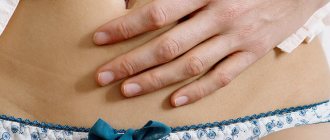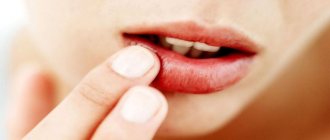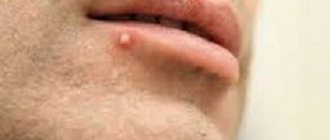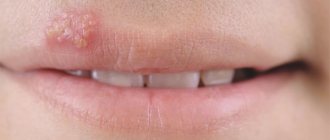Why do ulcers appear on a child’s lips?
Sores on the lips of a child are not uncommon. Babies constantly put toys in their mouths, especially when they are teething. Because of this, they can easily injure the oral mucosa.
Treatment of oral cavity in children is not a quick process. It is necessary to avoid injury and irritation of the wound, which is inflamed and sore. The child tries to scratch it or tear it off. When the sore gets infected, it begins to get wet and hurt, and does not heal for a long time. The baby becomes nervous and capricious.
Mouth ulcers may be accompanied by:
- Swelling of the inflamed area.
- Hyperemia, redness of the affected areas.
- The appearance of pus, the formation of an abscess.
- Blistering lesions that can coalesce and develop into a large ulcer.
A wound on the inside of a child’s lower lip indicates the development of stomatitis. With this disease, the child becomes irritable and capricious and refuses to eat. It is necessary to adjust the baby's diet. Food should be soft or ground, without a pronounced taste, and warm. Compliance with these rules will prevent injury to the ulcer, which can cause the wound in the mouth to become even more inflamed.
Before starting treatment for your child at home, you should consult a pediatric dentist. The specialist will determine the nature of the erosive formation on the inside or outside of the baby’s lip and prescribe the optimal treatment. Independent attempts to remove the ulcer can lead to the progression of inflammation and the development of serious complications.
Why does a white film appear after sleep?
It is difficult to give a definite answer to the question why plaque accumulates near the mouth in the morning. There can be many reasons. Some are more harmless, others are alarming.
A white film on the lips after sleep occurs due to involuntary drooling at night. Saliva has a bactericidal effect and is involved in the primary processing of food, which simplifies its swallowing and digestion.
At night, the secretion of the salivary glands slows down, and the discharge decreases several times. Sometimes the glands continue to function at full capacity at night. Saliva dries on the lips, leaving a residue in the form of light spots. The mucous membrane is easily visible through this plaque, it does not have a strong odor, and there are no other symptoms that would cause discomfort.
Nighttime drooling occurs when:
- stuffy nose;
- increased stomach acidity;
- inflammation in the gastrointestinal tract;
- helminthic infestations;
- disturbances in the functioning of the nervous system;
- infectious diseases in the oral cavity (caries, periodontal disease).
The formation of dry transparent crusts on the lips caused by constant dry mouth is a consequence of xerostomia, which develops against the background of hyposalivation in various disorders and diseases:
- lack of vitamin A, B and E in the body;
- Chronic mumps;
- neurological disorders;
- dysfunction of the salivary glands;
- period of menopause in a woman;
- botulism;
- Sjögren's syndrome.
If plaque forms daily and covers the lips and tongue with a thick white layer, and after removal during morning hygiene, appears again, this indicates the presence of internal problems or damage to the oral cavity by a fungal infection.
Pay attention to accompanying symptoms:
- plaque color (white, brown, yellow);
- consistency and appearance (thick, curdled, dry, wet, sticky);
- the presence of an unpleasant odor;
- pain in the abdomen, side, throat;
- poor appetite;
- disturbing dream.
If a dark, yellow, brown or almost black thick, sticky coating is found on the lips in the closure zone in the morning, then it becomes necessary to undergo examination by a gastroenterologist. This film can cover the gums, teeth, and tongue. It is difficult to wash off with water; normal hygiene is not enough to remove it.
The surface of the mucous membrane has to be scraped and rubbed to remove dried mucus. This phenomenon is often accompanied by dry mouth. Such symptoms indicate problems in the functioning of the abdominal organs, in most cases – inflammation of the pancreas. To eliminate it, it is necessary to treat the underlying disease.
Types of sores on the lips and their descriptions
There are many types of sores on the lips, but they are quite easily diagnosed by location and appearance. Ulcers inside and outside the mouth are symptoms of certain diseases. They are usually accompanied by pain, burning, itching, and discomfort.
The most common diseases that cause ulcers to form inside and outside the lips are:
- Numerous painful itchy ulcers that appear on the outside of the lips indicate activation of the herpes virus. Ulcerative herpes blisters can be localized not only inside the oral cavity, but also on the mucous membrane of the nose and facial skin.
- Wounds in the corners of the mouth, located both outside and inside, are called jams by many. The official name of this disease is angular stomatitis.
- White ulcers and pustules on the inside of the lip most often indicate candidiasis or aphthous stomatitis. This dental disease is characterized by severe pain, bad breath, and increased salivation.
- Damage to the outer skin of the lips by scaly formations, when removed, form bleeding wounds, is called cheilitis.
- An ulcer on the inside or outside of the lip can appear as a result of chemical or mechanical trauma.
- Sores on the lip, similar to herpes, may be the result of an allergic reaction. Allergens can cause swelling and soreness of the oral mucosa, the occurrence of erosive lesions and blisters.
- Cracks and wounds on the outer integument and mucous membrane of the lips are a favorable environment for the proliferation of pathogenic microorganisms. In most cases, ulcers appear due to infection of wounds in the mouth with staphylococci and streptococci.
More about the main pathological prerequisites
As for the pathological problems that lead to the appearance of the symptom in question, most often light discharge occurs due to viral infections, lack of vitamins and microelements, and disturbances in the gastrointestinal tract. Let's take a closer look at the most common reasons for the formation of white plaque on the lips.
This type of disease begins to develop against the background of excessive proliferation of opportunistic yeast-like fungi of the genus Candida, which live in every organism. People call this disease “thrush”. Patients with candidiasis often complain of the following symptoms:
- redness of the mucous membrane inside the mouth,
- a cheesy, white coating on the tongue and lips, as well as on the roof of the mouth,
- the appearance of blisters, painful ulcers that cause discomfort during eating and talking,
- sensation of itching and burning at the location of the wounds,
- fatigue, lack of appetite,
- In a newborn baby, plaque often causes an increase in body temperature.
The photo shows candidiasis.
The disease occurs against the background of such negative factors as chronic problems with the gastrointestinal tract, metabolic disorders, diabetes, stress, depression, antibiotic therapy, pathologies of the endocrine system and a sharp decline in immune defense. It is also transmitted to healthy people through kisses, personal hygiene and household items.
Thrush often occurs in women in the first trimester of pregnancy. This symptom disappears on its own, but it is still better for the patient “in pregnancy” to consult a doctor. Candidiasis is also diagnosed during hormonal imbalances, menopause, and during puberty. In a child, sometimes spots are the result of trauma to the mucous membranes and the subsequent formation of pathogenic microflora (if he hits himself or bites his lips).
If left untreated, the film acquires a brownish or greenish tint.
For candidiasis, specialists prescribe treatment, which includes a comprehensive intake of antifungal agents, application of creams and ointments. During the entire course, patients are advised to rinse their mouths with appropriate solutions.
An imbalance of bacteria (or dysbiosis) in the human body, provoked by taking medications and poor-quality food, often causes the accumulation of deposits on the tongue, similar to cheesy lumps. Plaque is not always easy to clean off from the outer part of the mucous membranes and in some cases has a foamy consistency, which indicates the presence of fungal flora. Characteristics of plaque in dysbacteriosis:
- the thickness of the film does not allow you to see the color of the tongue,
- wet and greasy consistency
- white color (a yellowish tint indicates a more severe form of dysbiosis),
- It can be removed easily, but quickly appears again.
In case of dysbacteriosis, plaque is easily removed, but also quickly reappears.
After carrying out the necessary diagnostic examinations confirming the disease, it is necessary to clean the tongue with special oils and solutions, and also restore the intestinal microflora.
This disease occurs as a result of prolonged malnutrition with a lack of any types of vitamins. The lack of these organic compounds causes a malfunction of the entire body and significantly affects the condition of the epithelium. Dry skin from dehydration cracks, a rash appears on it, and then a plaque forms.
Additional symptoms of vitamin deficiency are dulling and falling hair, thin and peeling nail plates, involuntary and painful muscle contractions, bleeding gums, tooth sensitivity, joint pain, decreased visual acuity, weight and slow development of bone mass in the baby.
With autotaminosis, lips become dehydrated, dry and dull.
Depending on the severity of the disease, the doctor prescribes the patient a course of physiotherapeutic procedures, intramuscular injections or oral medication. If all recommendations are followed, clots on the lips of the mouth will disappear very quickly.
Inflammation of the mucous membranes of the mouth, called stomatitis, is characterized by unpleasant, painful sensations when eating or drinking, the appearance of small vesicular blastulas, a light white film and elevated body temperature. In the absence of proper treatment, the patient may develop round purulent ulcers with smooth outlines, the process of salivation will also increase, and the lymph nodes located near the jaw will increase. For the same reason, clots often form inside the lip.
The photo shows stomatitis on the oral mucosa
. The infection spreads by contact, therefore, as soon as plaque appears in adults or children, you need to use separate utensils, and place the patient’s toothbrush away from the personal hygiene items of healthy people. This pathological condition is treated under the supervision of a doctor, since the treatment regimen consists of antiviral, painkillers and antibacterial agents.
The disease called diabetes is caused by a malfunction of the pancreas, which is responsible for the production of insulin. Without this hormone, sugar that is not converted into glucose accumulates in the blood, disrupts water metabolism, and fluid is excreted without remaining in the tissues. Therefore, people with diabetes complain of thirst, their skin dries out and peels, and the wounds on it take a long time to heal. Sometimes there is itching and films in the folds surrounding the mouth.
We suggest you familiarize yourself with white balls in the throat with an unpleasant odor
With diabetes, lips crack and do not heal for a long time.
Problem areas that appear in the corners of the lips often signal the onset of an inflammatory process in the mouth. It develops independently or is a symptom of another disease. Basically, cheilitis can be triggered by dermatosis that accompanies skin pathologies, allergies, or intensive growth of fungal bacteria provoked by taking antibiotics.
With cheilitis, problem areas appear in the corners of the lips.
Cheilitis is characterized by dry cracks in the corners of the mouth, followed by the appearance of films on the upper and lower lips. Treatment consists of taking anti-inflammatory, antifungal ointments, antihistamines in combination with hormonal ones.
One of the very first manifestations of the disease is burning, tingling on the lips and the formation of papules. Over time, the liquid in the transparent blisters becomes cloudy, they burst, turning into a weeping wound, and the damaged epithelium becomes covered with a film. Herpes causes discomfort in people, provokes the growth of lymph nodes and an increase in body temperature.
The photo shows herpes on the lips
Treatment should begin immediately - as soon as bubbles appear. Antiviral and immunomodulatory agents are prescribed as therapy.
The main reasons for the appearance of white spots on the lips
The most common cause of the defect in question is Fordyce disease. In this case, small nodules or granules appear under the skin. They do not hurt, do not itch and do not bother the woman at all. The described disease develops for several reasons, including smoking, hormonal imbalances, excessive production of skin secretions, etc.
Other factors that provoke the appearance of a light rash in the mouth area include infectious lesions, for example, the herpes virus. The list of possible provocateurs of a cosmetic defect also includes:
- poisoning of the body;
- gastrointestinal diseases;
- avitaminosis;
- stomatitis;
- disruptions in liver function;
- adrenal gland diseases;
- diseases of the endocrine system;
- Wen.
The cause of the pathology can be determined by the type of spots, as well as by their location. The white lesions can resemble herpes, be small like rashes, or quite large. Spots can be localized in the corners of the mouth, on the outside of the lip and even on the mucous membrane.
All about the causes of white plaque on the lips: how dangerous it is and how to get rid of the problem
White plaque on the lips and oral mucosa is a fairly common problem that causes aesthetic inconvenience and discomfort to a person. Sometimes such a symptom indicates the presence of quite serious diseases. It is worth finding out the etiology of this problem, as well as methods of treatment in both adults and children. This pathology will be discussed further in the material.
In some cases, the phenomenon in question appears periodically and at different times of the day. In other situations, the problem is present on an ongoing basis. For example, a person may notice plaque in the morning after sleep, during which the saliva flowing from the mouth dries, forming a whitish crust. This condition passes through a certain period and should not cause alarm.
- allergic reactions, which are caused, for example, by the use of toothpaste containing components that irritate the mucous membranes,
- vitamin deficiency associated with a lack of useful vitamins and microelements in the body - cracks appear in the corners of the lips, followed by a white coating,
- wearing uncomfortable or deformed orthopedic structures, which leads to injury to the mucous membrane and its drying out due, for example, to the inability to close the mouth normally,
- taking potent drugs, antibiotics, hormones and contraceptives, undergoing chemotherapy - all these factors can lead to changes in the composition of saliva and disruption of the protective functions of the oral mucosa,
- smoking and other bad habits - plaque in this case can be regarded as the first signal that it’s time to quit smoking and excessive alcohol consumption,
- dehydration of the body due to increased physical activity, as well as prolonged exposure to heat - dry mucous membranes lead to the appearance of small cracks around the lips and whitish discharge,
- problems with nasal breathing, due to which the mucous membrane often dries out, because you have to breathe through the mouth,
- prolonged depressive state - in such cases, the lower lip usually suffers mainly, on which, in addition to plaque, small pimples also appear. You need to reconsider your lifestyle, try to sleep at least 8 hours a day, or better yet, take a vacation from work and have a good rest, because the result of stress is not only plaque, but also other malfunctions in the internal systems of the body,
- poor nutrition, excessive consumption of salty, sweet, smoked, heavy and fatty foods, leading to problems such as dysbiosis, gastritis and other gastrointestinal disorders,
- systemic pathologies such as diabetes mellitus,
- viral and bacterial infections, which are most often caused by decreased immunity and poor oral hygiene.
If the plaque goes away after some time, then there is no need to worry
. It is worth noting that a light film may well be the result of using low-quality lipstick or gloss. Some cosmetic products add components that promote drying and peeling of the epithelium. To solve the problem, just stop using low-quality cosmetics.
What does the formation of a whitish film mean? You can conduct preliminary diagnostics and identify the suspected cause of the problem by its location and main characteristics:
- cheilitis, herpes - clots form on the outside of the lips,
- candidiasis - accumulation on the inside of the lips in the form of a cheesy layer,
- problems of the gastrointestinal tract - clots look like a sticky film,
- vitamin deficiency, alcohol and nicotine addiction - a whitish coating collects in the corners of the mouth.
Accumulations under the lip also occur with fungal infections of the mucous membrane. If they cover the palate, tonsils, the inside of the cheeks and the tongue, then this is a severe form of infection. In men, this type of formation is most often the result of smoking.
External factors that cause this symptom:
- alcohol and nicotine abuse,
- lack of sufficient oral hygiene,
- regular nervous and physical stress,
- installed dentures,
- unbalanced diet,
- treatment with antibiotics, as well as the use of hormonal drugs,
- dehydration of the body,
- Living in hot or cold climates causes dry lips, which leads to the appearance of white plaque. This discomfort often worries people even after sleep, since at night the lips are not wetted with saliva and their skin dries out,
- damage to the surface of the skin-muscular folds covering the oral cavity with various objects, which leads to the penetration of bacteria into the open wound,
- carrying out chemotherapy.
We suggest you familiarize yourself with How to smear Metrogyl Denta on your gums
Diseases characterized by the appearance of white plaque:
- avitaminosis. The lack of essential micronutrients provokes a decrease in the protective function, so the human body is not able to resist the effects of pathogenic bacteria and viruses. The infection affects the area of the skin-muscular folds of the mouth,
- HIV,
- inflammation of the oral mucosa (stomatitis, gingivitis),
- gastrointestinal diseases (ulcers, pancreatitis, gastritis),
- candidiasis,
- liver pathologies,
- tonsillitis,
- scarlet fever,
- diabetes,
- hypothyroidism, characterized by hormonal imbalances,
- respiratory diseases causing infection of the upper respiratory tract. Due to constant swelling of the nose, the lips begin to dry out, which contributes to the formation of a white film on their surface.
During an external examination of the patient, a specialist will determine in laboratory conditions the cause of pale lips. The examination evaluates:
- Color.
- Allergic reactions on the body.
- Condition of the oral cavity.
In order to determine the cause of pallor, it is necessary to carry out a diagnosis. The following tests will be required:
- urine;
- blood;
- plaque from the oral mucosa.
Based on signs indicating intestinal or gastrointestinal diseases, the doctor prescribes an ultrasound. In rare cases, an MRI.
After receiving the data, the doctor will clearly determine the cause of the disease:
- The determination of VSD will indicate fluctuations in blood pressure during physical activities, as well as an orthostatic test.
- A decrease in the level of red blood cells and hemoglobin indicates anemia. The disease will be indicated by a biochemical blood test based on low ferritin levels.
- The speed of blood circulation when determining damage to the blood vessels of the brain can be shown by ultrasound. It can be used to examine the spinal and carotid arteries.
If your stomach hurts, there is nausea, or there has been vomiting, the doctor may prescribe an intubation.
Treatment of sores on the lips with folk remedies
Drug treatment of ulcers that have formed on the inside of the lower or upper lip can be carried out in combination with the use of folk remedies. However, before using alternative medicine recipes, you should consult your doctor.
The wound heals faster if you use the following folk remedies:
- To quickly get rid of sores, use baking soda. The recipe for preparing the solution is simple: a teaspoon of soda is diluted in a glass of warm boiled water. The solution is used for daily rinsing and applying compresses to the affected areas.
- A purulent ulcer on the lip from the outside or inside will quickly heal if you moisten it with Kalanchoe juice. For this, use a fresh, only cut leaf, cut in half. It is applied to the sore with the wet part. Kalanchoe juice effectively “pulls out” pus, relieves pain, cleanses and heals the wound.
- A real “savior” from wounds and mouth ulcers is a decoction or tincture of oak bark. The products can be used in the form of rinses and compresses. Astringents and tannins contained in tree bark help cure inflammation and accelerate healing. The decoction is used for daily rinsing of the mouth. Tincture - for lotions, when you take a piece of cotton wool or gauze, moisten it with an infusion of oak bark and apply it to the inflamed area.
- Ulcers will go away faster if you use herbal decoctions of chamomile and calendula flowers. Rinsing your mouth with herbal decoctions will help get rid of inflammation. These plants relieve pain and disinfect the affected area. Recipe: take 2 tablespoons of flowers, pour a glass of boiling water, let it brew for 10-15 minutes. The cooled broth should be used twice a day.
Ulcers on the inside of the lips go away faster if you rub the inflammation with natural oils.
Locations of plaque on the lips
The following areas of microbial clot layering are distinguished:
- corners. The reasons for such plaque are abuse of alcoholic beverages and nicotine, vitamin deficiency, candidiasis, neglect of hygienic cleaning of the oral cavity,
- outer surface (herpes, cheilitis, xerostomia),
- inner side. The mucosal fungus with candidiasis spreads to the musculocutaneous folds of the mouth in the form of a cheesy layer, and in case of problems with the gastrointestinal tract it appears as a sticky film.
Methods of treating the disease
To get rid of ulcers on the inside of the lip, an integrated approach is used, which is aimed both at eradicating the root cause and at speedy healing of the wounds. To block the underlying disease use:
- Antibiotics.
- Anti-inflammatory drugs.
- Antiseptic rinse solutions.
Treatment of ulcers is possible only if hygiene rules are observed. It is necessary to exclude the possibility of their growth. For this use:
- Rinse with hydrogen peroxide or saline solution.
- Using ointments that are sold without a doctor's prescription.
- Folk remedies such as applying ice, used tea bags and much more to wounds.
To eliminate the possibility of new damage, it is recommended to use soft toothbrushes and change them at least once every three months. It is recommended to limit the intake of hot and solid foods, eliminate smoking and drinking alcohol.
We suggest you familiarize yourself with the Taste of iron in the mouth - an alarming signal
How to get rid of white plaque on lips?
The presence of such a symptom for a long period of time is due to the development of a pathological process, so it is necessary to contact a medical institution, where a doctor will determine the cause of its occurrence. Only after this does he prescribe therapy, which is based on taking the following drugs:
- anti-inflammatory (Kamistad, Acyclovir),
- antifungal (Clotrimazole and Nystatin ointments),
- antiseptic solutions for disinfecting the oral cavity (Miramistin, Chlorhexidine),
- painkillers. Used to eliminate pain during meals (Lidocaine, Benzocaine),
- antibiotics. Drugs of the penicillin and cephalosporin group are prescribed for severe forms of the disease,
- agents that have a regenerative effect on damaged tissue (Solcoseryl, sea buckthorn oil),
- To restore the body's protective functions, immunostimulants and multivitamin complexes are used.
Homeopathic remedies to eliminate white plaque:
- Borax. Provides healing of ulcers due to stomatitis,
- Kalium bichromicum. It is an effective remedy for removing microbial clots from the inner surface of the lips,
- Antimonium crudum. Helps with candidal stomatitis,
- Kalium muriaticum. Used for stomatitis and thrush, ensures healing of ulcers,
- Mercurius solubilis. The drug can eliminate symptoms in severe cases of damage to the oral mucosa.
We invite you to read: Your son is growing: norms of sexual development of boys
Before starting to take such medications, consult your healthcare professional.
When eliminating microbial accumulation, you must follow the following doctor’s recommendations:
- carrying out sanitation of the oral mucosa with decoctions of chamomile, yarrow, calendula or sage. Medicinal plants have many beneficial properties and will help speed up treatment,
- keep plenty of fluids to avoid drying out the mucous membranes,
- balance your diet with a minimum of glucose and simple carbohydrates. Products must contain the required amount of essential micronutrients. It is recommended to consume food in boiled form,
- using hygienic lipstick, which will prevent cracking and infection of the lips,
- when treating with antibiotics, it is necessary to enrich the diet with fermented milk products that contain probiotics,
- thoroughly and promptly clean the oral cavity, taking precautions not to cause injury to the mucous membrane (soft brush, do not pick between the teeth with sharp objects to remove food debris),
- Quit smoking or minimize the number of cigarettes you smoke.
Do you feel nervous before visiting the dentist? Yes No Having a denture requires a person to eliminate a negative factor. In this case, you need to visit a dentist who will identify the cause of the formation of white plaque on the lips and tell you how to prevent its reappearance.
Multiple rashes
Small white spots on the inside of the lip may appear due to Fordyce's disease. It is rare and unexplored. At this moment, there are no medications that are 100% likely to cure this pathology.
But there is a positive aspect to this - the spots formed due to Fordyce's disease do not cause discomfort.
The cause of the appearance of many white formations may be stomatitis. This is the most common cause of rashes that cause itching and pain in the patient. Due to stomatitis, the entire oral mucosa can be filled with white marks, this will be noticeable.
New growths on the lips
They can be either benign or malignant. But such symptoms should not be left to chance in any case, since the cells can degenerate and cause serious complications, including death. In practice, doctors encounter the following tumors:
- Oncology – cancers are the most dangerous to human life. Initially, they look like a flat white spot on the surface of the mucosa. As it develops, it becomes covered with ulcers, bleeds, and painful sensations arise. The spot grows in volume and becomes denser and harder.
- A cyst is a kind of white ball under the skin; sometimes it protrudes on the surface of the mucous membrane and can be easily felt. There is a clear liquid inside. Most often, a cyst is diagnosed on the lower lip. The causes of this phenomenon may be excessive salivation, piercing, mechanical damage to the skin, for example, from frequent biting due to nervousness.
- Fibroma is another benign formation. Appears as a result of disruption of the connective tissue structure. This is a dense tubercle of a light shade that can match the color of the lip. Occurs after injury or from wearing unsuitable dentures.
- Lipoma is a pathology that manifests itself as inflammation of the sebaceous glands. In this case, whitish balls form on the mucous membrane, as the body makes “reserves” of adipose tissue. This happens as a result of long-term strict diets, forced fasting, and a severe lack of nutrients for the normal functioning of organs.
- Atheroma is also a benign formation resulting from blockage of the sebaceous glands. If left unattended, the cells can develop into cancer over time.
When a white spot on the lip hurts, it is advisable to consult a specialist as soon as possible in order to identify a serious disease in the early stages. Then there is a better chance of getting rid of it without any sad consequences.
Does treatment with folk remedies help?
Some representatives of the fair sex tend to trust traditional medicine. Sometimes such trust is justified. In the case of the described illness, the use of folk remedies will only help a woman reduce the appearance of spots on her lips and make them less noticeable. It will not be possible to completely overcome the disease thanks to “grandmother’s” recipes.
If the goal of your treatment is to reduce the severity of light-colored rashes on the lips, a few traditional medicine tips will help you:
- Tear off a Kalanchoe leaf and secure it with an adhesive plaster to the affected area. Use the procedure twice a day for a week.
- Melt the lamb fat and rub it into your lip for 30 minutes. Repeat the procedure daily until the spots are completely lightened.
- Wrap the chewed wheat (grains) with gauze and apply it to the white spots, secure the compress with film. Change the contents of the gauze in the morning and evening for 4 days.
- Grind the garlic into a pulp, add a little oil. Rub the resulting mixture onto your lips daily for 30 days.
- Coat a small onion with honey and place it in the oven for 20 minutes. Place the baked onion on your lip for 30 minutes. You can use the juice by rubbing it on the affected area. Repeat the procedure five times.
- Use propolis oil. The product can be purchased ready-made at the pharmacy. To prepare it yourself, you need to mash the propolis in a glass container and pour the ingredient with a small amount of olive oil, leave to brew for a day. Lubricate the stains with the prepared (decanted) product. Repeat the manipulation three times a day for 7 days.
- As an alternative, fir oil is used. The product is applied to the affected area and left for 10 minutes, after which it is washed off and moisturized with lip balm.
- Crush the mummy tablet, melt a little honey and mix the ingredients. Lubricate your lip with the resulting mixture, leave for 10 minutes and rinse.
We invite you to familiarize yourself with what the tongue of a healthy person looks like (photo, structure): color changes and diseases
Before you start self-medicating, even with the most proven folk remedies, do not forget to consult a specialist!
Causes of lip ulcers
Factors leading to the formation of the disease can be divided into two large groups. The first of these is viral infections. The main reasons for the appearance of ulcers on the lips in these cases:
- Aphthous stomatitis. Bubbles appear on the mucous membrane, which quickly burst and turn into ulcers.
- Herpes virus. Generates blisters with red edges. In children who frequently suck their thumbs, the disease can spread to their hands.
- Candidiasis. It appears as a white coating on the tongue and lips, burning sensation. There is practically no pain.
In addition to viral infections, traumatic injuries can cause lip ulcers. Damage to the mucous membrane reduces its protection. This can happen when:
- Burns or hypothermia.
- Careless handling of the toothbrush.
- Biting.
- Chemical irritation from smoking or drinking alcohol.
- Lack of oral hygiene.
Usually, if you follow simple rules, ulcers on the inside of the lips go away on their own within a few weeks. If there is no improvement, you need to consult a doctor. In such cases, their appearance may be caused by the consequences of HIV, Corn's disease or ulcerative colitis.
Which doctor should I contact?
If white spots appear on the lips or around the mouth, you should visit a physician or dermatologist. After examination and diagnosis, consultation with a venereologist, infectious disease specialist, dentist, or cosmetologist may be required.
Consult a dermatologist for treatment of pathologies on the lips
If ulcers and inflammation on the lips do not go away for more than two weeks, are accompanied by pain when swallowing, or a tumor in the neck area, consult a doctor.
Prevention
To avoid the appearance and treatment of a white sore on the inside of the lip, a photo of which can be seen in the article, you must adhere to simple preventive methods:
- Get rid of bad habits.
- Carefully monitor oral hygiene.
- Hygiene must be especially careful when wearing braces.
- Carefully care for your dentures. It is better to choose the latter from good, expensive materials. Do not let your child put dirty hands and objects, toys, etc. in his mouth.
- Do not bite your lips or lick them in windy, cold weather.
- Don't get too cold.
- Visit the dentist's office regularly.
- Treat caries in a timely manner.
- Eat food and drinks at medium temperature, avoid sudden temperature changes (ice cream and hot coffee, for example).
- Carefully handle the dishes of a sick person, do not use other people’s hygiene products.
As you can see, it is not difficult to avoid the formation of sores on the lips if you follow all these recommendations. There are many reasons that can lead to sores on the inside of the lips (lower or upper). Treatment usually takes a long period, so it is better to prevent their occurrence than to treat them.
Preventive measures
The following set of preventive measures will help prevent the occurrence of sores on the lips, regardless of the cause of their occurrence:
- Maintaining hygiene rules. Oral hygiene includes mandatory twice-daily brushing of teeth and tongue, and the use of dental floss. It is recommended to rinse your mouth after each meal. Personal hygiene includes the use of an individual towel. Dishes and kitchen utensils must be kept clean.
- Complete and rational nutrition. Vitamins and minerals support the immune system and enhance the body’s ability to resist infectious diseases.
- Taking vitamin-mineral complexes. It is necessary to constantly replenish the lack of necessary elements and substances in the body. If an abscess has already appeared, the use of vitamins B and E is indicated.
- Compliance with the work and rest regime. You need proper rest, restful, sound sleep, which allows you to restore expended energy. It is necessary to respond adequately to stressful situations, to prevent the occurrence of neuroses and nervous breakdowns. Normalized physical activity helps strengthen the immune system, provides the necessary energy, and heals the body.
- Minimal contact with infected people. It is necessary to minimize and, if possible, completely stop contact with people who are sick or have recently had infectious diseases.
- Regular visits to the dentist. A doctor can detect and prevent the development of many dental diseases in time.
- Therapist consultations. A specialist can promptly identify and stop pathologies that provoke the appearance of sores in the mouth.
Ulcers in the mouth area are a symptom, the cause of which can only be determined by a specialist. Therefore, the appearance of erosive formations on the inside or outside of the lip is a good reason for immediately contacting a dentist or therapist.
White plaque as a symptom of the disease
Stomatitis
With this disease, not only the lips, but also most of the oral mucosa (inner cheek area, palate and tongue) are covered with a white substance. Signs of stomatitis:
- redness of the affected area,
- the formation of ulcers, which may be purulent in nature,
- increased salivation,
- bleeding gums,
- burning and itching at the site of ulcer formation,
- feeling of pain when eating and talking,
- temperature increase,
- bad breath,
- In some forms of stomatitis, enlargement of the lymph nodes is possible.
The infection is transmitted by contact, so when a white coating appears, it is worth giving the person separate dishes and keeping the toothbrush away from the brushes of other family members.
The main causes of stomatitis are weakened immunity, insufficient hygiene and oral trauma.
Candidiasis
The disease is a fungal infection of the mucous membrane. These fungi of the genus Candida are always present in the human body, but with a decrease in the protective properties of the immune system, their numbers increase. During their reproduction, the intestinal, oral and vaginal mucosa of females becomes infected. Like stomatitis, candidiasis is transmitted by contact.
The disease is characterized by the following clinical picture:
- redness of the mouth
- cheesy coating, both on the oral mucosa and on the lips (in most cases on the lower). At the same time, cracks can often be seen on the surface of the lips,
- the formation of blisters at the beginning of the disease, in the place of which painful ulcers subsequently appear. They cause discomfort when eating and talking,
- burning and itching in the affected area,
- fast fatiguability,
- loss of appetite,
- If left untreated, the plaque becomes green or brown.
Stomatitis
Candidiasis
A small amount of whitish clots is often a consequence of the vital activity of organisms living in the mouth. If the formation of a film is not accompanied by discomfort or pain, and the film itself is easily cleaned off, then you don’t need to panic. But plaque should cause alarm if the following accompanying symptoms occur:
- unpleasant, putrid odor from the mouth,
- decreased functionality and mobility of the tongue,
- change in consistency and shade of plaque,
- restless sleep,
- loss of appetite,
- painful sensations in the throat, abdominal part.
We invite you to familiarize yourself with Vibrocil analogues that are cheaper - inexpensive analogues of Vibrocil drops and spray for children and adults
An unpleasant accompanying symptom of the problem may be bad breath.
The listed signs can signal serious pathologies and require an immediate visit to the doctor. Based on the test results, he will identify the causes and determine treatment tactics.











